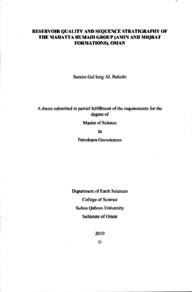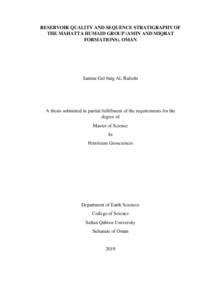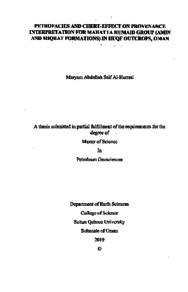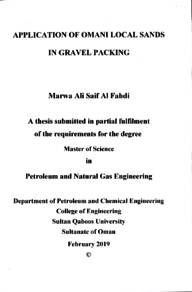وثيقة
Reservoir quality and sequence stratigraphy of the Mahatta Humald Group (Amin and Miqrar formations), Oman.
الناشر
Sultan Qaboos University
ميلادي
2019
اللغة
الأنجليزية
الملخص الإنجليزي
Amin and Miqrat formations of Early to Middle Cambrian age act as the most important subsurface reservoirs in north of Oman. This thesis project attempts to delicate the major diagenetic alterations and subsequently to determine their impact on reservoir quality of the studied Amin and Miqrat formations along with constructing a sequence stratigraphic framework of Migrat and Amin formations
This thesis project based on textural, petrographic description and compositional analysis along with several goochemical analysis (SEM,EDS, XRD and Stable C and O-Isotopes of carbonate cements) of Huqf outcrop-based and Saiwan East 2 Field core-based sandstone samples from the studied Amin and Mique formations in order to assess the distribution of dingenetic alterations and their subsequent impact on the reservoir quality and (ii) the analysis of four wells using Petrel Schlumberger's software to identify lithology, electrofacies, depositional environment and to build up a sequence stratigraphic framework of Amin and Migru formations
Amin Formation outcrop-based samples consist of very fine to very course grained litharenite to sublitharenite sandstones and Amin core-based samples are silt to counse-grained sublitharenite sandstones. Whereas, Miqrat outcrop based samples consist of course silt to coarse-grained subfieldsarenite to sublithaenite and rarely quartzarenite sandstones. Miqrat core-based samples are medium silt to mediumgrained subfeldsarenite to lithic arkose sandstones.
The reservoir quality of Amin and Miqrat sandstones have been modified during three stages of dingenesis codiagenesis mesodiagenesis and telediagenesis. Reservoir quality of Amin Formation in codiagenetic stage was controlled by the mechanical compaction, dissolution of unstable grains and cementation by kaolinite and siderite type 1. The mesodiagenetic stage includes chemical compaction and cementation by quartz. Whereas, calcite and siderite type II might be precipitated cither during mesodiagenesis or tlodiagenesis stage. On the other hand, the reservoir quality of Migrat Formation in codiagenesis stage was controlled by mechanical compaction, dissolution of unstable grains and cementation by kalinite, siderite and calcite type 1 Quartz overgrowths, illite and dolomite cements are representing the diagenetic alterations in mediagenesis stage. Whereas, calcite type Il might be precipitated during mediagenesis or telodiagenesis. All of these dingenetic alterations have a negative impact on reservoir quality of Amin and Miqrat by reducing the primary porosity except the dissolution of chemically unstable grains that contributed in enhancing the reservoir quality,
The sequence stratigraphic framework of Amin and Miqrat formations contains part of depositional sequence including lowstand system tract and transgressive system tract. The lowstand system tract represented by deposition of Amin Formation that had deposited above Angudan unconformity (sequence boundary). The transgressive surface placed within the upper most part of Amin Formation evidenced by presence of rippled sandstones and the iron oxide crust. Whereas, transgressive system tract represented by deposition of Miqrat Formation marked by presence of wave and current ripples.
المجموعة
URL المصدر
قالب العنصر
الرسائل والأطروحات الجامعية








